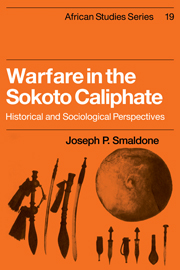Book contents
- Frontmatter
- Contents
- List of Illustrations and Tables
- Preface
- Conventions and Abbreviations
- General Glossary
- Map 1 The Western Sudan
- Part One Historical Perspectives
- 1 Introduction: Sudanic Warfare and Military Organization to c. 1800
- 2 The Jihad Period, c. 1790–1817
- 3 Military Organization in the Sokoto Caliphate, c. 1817–1860
- 4 Organization for Defense and Security
- 5 The Theory and Practice of War
- 6 The Firearms Trade in the Central Sudan: The Expansion of the “Gun-frontier”
- 7 Firearms in the Sokoto Caliphate, c. 1860–1903
- Part Two Sociological Perspectives
- Notes
- Bibliography
- A Glossary of Hausa-Fulani Military Titles
- A Glossary of Hausa Military Terminology
- Index
7 - Firearms in the Sokoto Caliphate, c. 1860–1903
Published online by Cambridge University Press: 04 August 2010
- Frontmatter
- Contents
- List of Illustrations and Tables
- Preface
- Conventions and Abbreviations
- General Glossary
- Map 1 The Western Sudan
- Part One Historical Perspectives
- 1 Introduction: Sudanic Warfare and Military Organization to c. 1800
- 2 The Jihad Period, c. 1790–1817
- 3 Military Organization in the Sokoto Caliphate, c. 1817–1860
- 4 Organization for Defense and Security
- 5 The Theory and Practice of War
- 6 The Firearms Trade in the Central Sudan: The Expansion of the “Gun-frontier”
- 7 Firearms in the Sokoto Caliphate, c. 1860–1903
- Part Two Sociological Perspectives
- Notes
- Bibliography
- A Glossary of Hausa-Fulani Military Titles
- A Glossary of Hausa Military Terminology
- Index
Summary
In earlier chapters we noted that the revolution in army organization and warfare that occurred in the emerging emirates of the caliphate during the jihad period actually involved the adoption of traditional Sudanic military institutions and practices. Despite the general increase in the availability and use of firearms in the late nineteenth century, these traditional modes of warfare and military organization remained remarkably intact until the European conquest of the Sudan. Recalling the similar transient appearance of guns in sixteenth-century Bornu, Fisher and Rowland have contended that the limited effect of firearms in the late nineteenth century represented merely the recurrence of a cyclical historical pattern that periodically manifested itself in the Sudan: a sudden impact of firearms that was sustained nowhere, whose potential significance faded quickly into history without a trace. In their own words, “Had the imposition of European rule not radically altered the position, it is possible to imagine that firearms, even on Rabin's scale, would not have altered the longstanding central Sudan pattern, of dramatic impact followed by rapid decline into nearly total ineffectiveness.”
As we observed in the last chapter, a combination of factors, particularly the nature and volume of the firearms trade, precluded the occurrence of a fundamental transformation in Sudanic military organization and warfare. Nevertheless the attribution by Fisher and Rowland of only a marginal and transitory impact to firearms has obscured the potential significance of these weapons. It is our contention that the introduction and use of an increasing number of firearms did in fact produce an incipient revolution in Central Sudan.
- Type
- Chapter
- Information
- Warfare in the Sokoto CaliphateHistorical and Sociological Perspectives, pp. 110 - 124Publisher: Cambridge University PressPrint publication year: 1977
- 1
- Cited by

